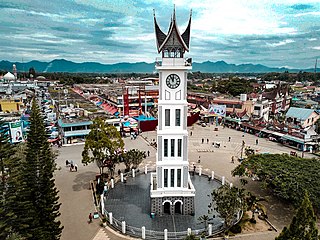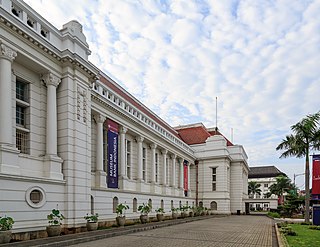
Bukittinggi is the third largest city in West Sumatra, Indonesia, with a population of 111,312 in 2010 and 121,028 in 2020, and an area of 25.24 km2. It is in the Minangkabau Highlands, 90 km by road from the West Sumatran capital city of Padang. The whole area directly borders to the Agam Regency, making it an enclave, and is located at 0°18′20″S100°22′9″E, near the volcanoes Mount Singgalang (inactive) and Mount Marapi. At 930 m above sea level, the city has a cool climate with temperatures between 16.1° to 24.9 °C.

Menteng is the south-central district of Central Jakarta, one of the administrative municipalities in the capital city Jakarta, Indonesia.

Bank Indonesia (BI) is the central bank of the Republic of Indonesia. Perry Warjiyo is its current governor.

Jatinegara is one of the districts (Kecamatan) of East Jakarta, Indonesia. The name also refers to the larger, historic area of the colonial town of Meester Cornelis. Established in the 17th century, Jatinegara is one of the oldest areas in Jakarta, and contains a number of buildings from the colonial period.

Kota Tua Jakarta, officially known as Kota Tua, is a neighborhood comprising the original downtown area of Jakarta, Indonesia. It is also known as Oud Batavia, Benedenstad, or Kota Lama.

The National Museum of Indonesia, is an archeological, historical, ethnological, and geographical museum located in Jalan Medan Merdeka Barat, Central Jakarta, right on the west side of Merdeka Square. Popularly known as the Elephant Museum after the elephant statue in its forecourt. Its broad collections cover all of Indonesia's territory and almost all of its history. The museum has endeavoured to preserve Indonesia's heritage for two centuries.

Jakarta is Indonesia's capital and largest city. Located on an estuary of the Ciliwung River, on the northwestern part of Java, the area has long sustained human settlement. Historical evidence from Jakarta dates back to the 4th century CE, when it was a Hindu settlement and port. The city has been sequentially claimed by the Indianized kingdom of Tarumanegara, the Hindu Kingdom of Sunda, the Muslim Sultanate of Banten, and by Dutch, Japanese and Indonesian administrations. The Dutch East Indies built up the area before it was taken during World War II by the Empire of Japan and finally became independent as part of Indonesia.

The Jakarta History Museum, also known as Fatahillah Museum or Batavia Museum, is located in the Old Town of Jakarta, Indonesia. The building was built in 1710 as the Stadhuis of Batavia. Jakarta History Museum opened in 1974 and displays objects from the prehistory period of the city region, the founding of Jayakarta in 1527, and the Dutch colonization period from the 16th century until Indonesia's Independence in 1945.

Dutch colonial architecture in Indonesia were built across the archipelago that once was known as Dutch East Indies. Most of the better and permanent colonial era structures are located in Java and Sumatra, which were economically considered more important during the Dutch imperial period. As a result, there are large number of colonial buildings concentrated in its cities. Plenty of old VOC era forts and warehouses are also scattered throughout the archipelago, particularly around Maluku Islands and Sulawesi. There are three Dutch colonial architectural styles:

Colonial buildings and structures in Jakarta include those that were constructed during the Dutch colonial period of Indonesia. The period succeeded the earlier period when Jakarta, governed by the Sultanate of Banten, were completely eradicated and replaced with a walled city of Batavia. The dominant styles of the colonial period can be divided into three periods: the Dutch Golden Age, the transitional style period, and Dutch modernism. Dutch colonial architecture in Jakarta is apparent in buildings such as houses or villas, churches, civic buildings, and offices, mostly concentrated in the administrative city of Central Jakarta and West Jakarta.

Mohammad Husni Thamrin was a pre-independence Indonesian political thinker and nationalist who after his death was named a National Hero.

Bank Indonesia Museum is a bank museum located in Jakarta, Indonesia. It was founded by Bank Indonesia and opened on 21 July 2009. The museum is housed in a heritage building in Jakarta Old Town that had been the first headquarters of the Netherlands Indies gulden, the central bank of the Dutch East Indies. The bank was nationalized as Bank Indonesia in 1953, after Indonesia gained its independence. It is located next to Bank Mandiri Museum.

Bank Indonesia Museum is a bank museum located in Surabaya, Indonesia. It was officially founded by Bank Indonesia and was opened on 27 January 2012 after its restoration. The museum occupies a building formerly known as De Javasche Bank, the central bank of Dutch East Indies. After the Indonesian Independence the building continued to function as the Bank Indonesia's branch in Surabaya until 1973. The museum is closed on Monday and public holidays. It has no entrance fee.

Indies Empire style is an architectural style that flourished in the colonial Dutch East Indies between the middle of the 18th century and the end of the 19th century. The style is an imitation of neoclassical Empire Style which was popular in mid-19th-century France. Conformed to the tropical setting of Indonesia, the style became known in the Dutch East Indies as Indies Empire style.

Pancasila Building is a historic building located in Central Jakarta, Indonesia. The name "Pancasila" refers to the speech delivered by Sukarno in the building on which he explained the concept of Pancasila, a philosophical concept which would be the foundation of the Indonesian nation, on June 1, 1945. Built in the early 1830s, the building is one of the many 19th-century colonial landmarks in Jakarta. The Pancasila Building currently belongs to and is under the preservation of the Indonesian Ministry of Foreign Affairs.

Jakarta City Hall is the seat of the Jakarta City government. The complex contains the official office of the governor and the vice governor of Jakarta, and the main administrative office. Jakarta City Hall is located south of Merdeka Square.

Tandjong West was a particuliere land or private domain in modern-day Tanjung Barat, Jagakarsa, South Jakarta, Indonesia. The center of the domain was the eponymous Landhuis Tandjong West, an eighteenth-century Dutch colonial manor house.
Willem Hendrik de Greve was a Dutch geologist. He was known for his discovery of the coal mine in Sawahlunto, Dutch East Indies.

The following outline is provided as an overview of and topical guide to Jakarta:




















